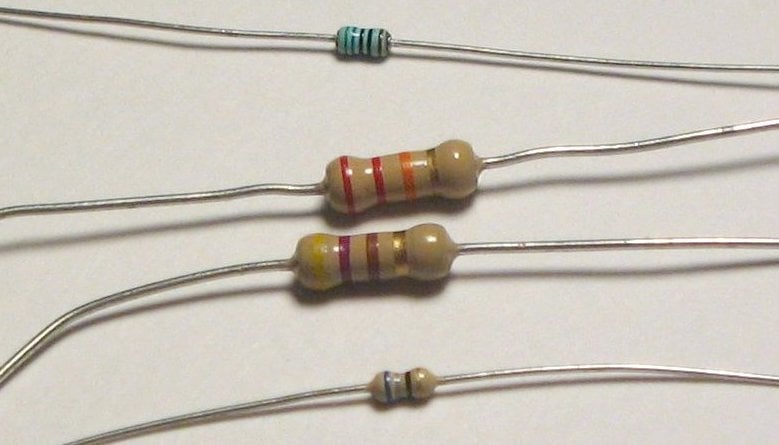A resistor is a passive two-terminal electrical device that resists the flow of current. It is probably the simplest element in an electronic circuit. It is also one of the most common components as resistance is an inherent element of nearly all electronic circuits. They are usually color-coded.

1. Composition
A resistor is not a fancy device at all because resistance is a natural property possessed by almost all conductors. So, a capacitor consists of a copper wire wrapped around an insulating material such as a ceramic rod. The number of turns and the thinness of copper wire are directly proportional to the resistance. The higher the number of turns and thinner the wire, the higher the resistance.
You can also find resistors made of a spiral pattern of a carbon film. Hence, the name carbon film resistors. They are designed for lower-power circuits because carbon film resistors are not as precise as their wire-wound counterparts. However, they are cheaper than wired resistors. Wire terminals are attached to the both ends. As resistors are blind to the polarity in a circuit, the current can flow through in either direction. So, there is no need to worry about attaching them in a forward or a backward direction.
B. How Does It Work?
A resistor may not look like much. One may think it doesn’t do anything except consume power. However, it performs a vital function: controlling the voltage and the current in your circuit. In other words, resistors give you control over the design of your circuit.
When electric current starts flowing through a wire, all the electrons start moving in the same direction. It’s just like water flowing through a pipe. Less amount of water will flow through a thin pipe because there is less room for its movement.
Similarly, when the current passes through a thin wire in a resistor, it becomes progressively harder for the electrons to wiggle through it. In short, the number of electrons flowing through a resistor goes down as the length and thinness of the wire increases.
C. Function and Significance
Resistors have plenty of applications, but the three most common ones are managing current flow, dividing voltage, and resistor-capacitor networks.
Limiting the Flow of Current
If you don’t add resistors to a circuit, the current will flow at dangerously high levels. It can overheat other components and possibly damage them. For example, if you connect an LED directly to a battery, it would still work. However, after some time the LED will heat up like a fireball. It will eventually burn as LEDs are less tolerant to heat.
But, if you introduce a resistor in the circuit, it will reduce the flow of current to an optimal level. Thus, you can keep the LED on longer without overheating it.
Dividing Voltage
Resistors are also used to reduce the voltage to the desired level. Sometimes, a particular part of a circuit such as a microcontroller may need a lower voltage than the circuit itself. This is where a resistor comes in.
Let’s say your circuit runs off of a 12V battery. However, the microcontroller needs only a 6V supply. So, to divide the voltage in half, all you have to do is place two resistors of equal resistance value in series. The wire in between the two resistors will have halved the voltage of your circuit where the microcontroller can be attached. Using appropriate resistors, you can lower the voltage within the circuit to any level.
Resistor-Capacitor Networks
Resistors are also used in combination with capacitors to build ICs that contain resistor-capacitor arrays in a single chip. They are also known as RC filters or RC networks. They are often used to suppress electromagnetic Interference (EMI) or Radio Frequency Interference (RFI) in various instruments, including input/output ports of computers and laptops, Local Area Networks (LANs), and Wide Area Networks (WANs), among others. They are also used in machine tools, switchgears, motor controllers, automated equipment, industrial appliances, elevators, and escalators.
Related Posts:
